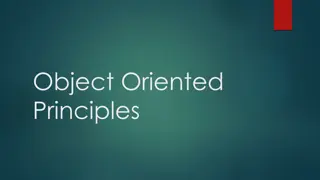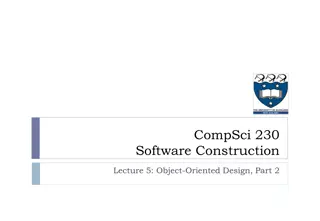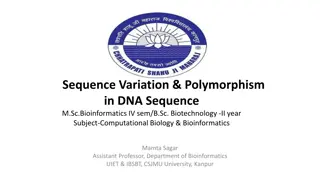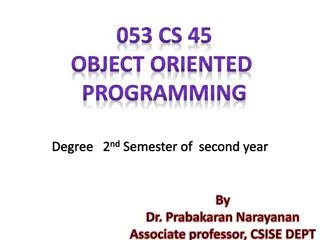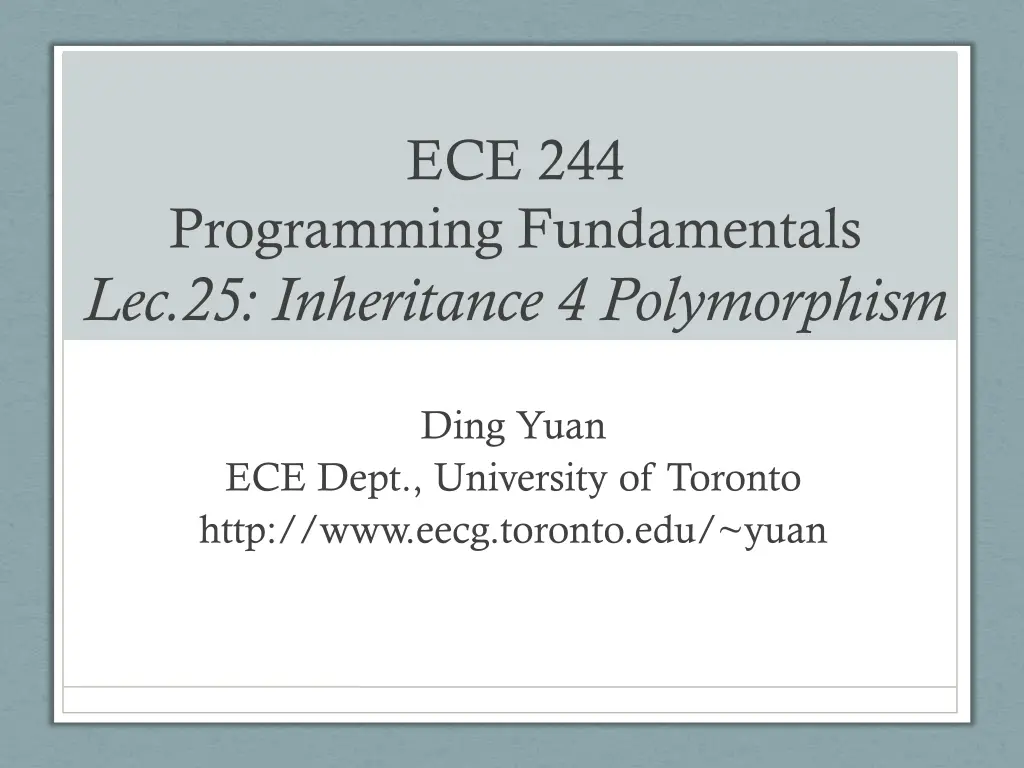
Understanding Polymorphism and Virtual Functions in C++
Explore the concepts of polymorphism and virtual functions in C++, how they enable dynamic function invocation through pointers, and their real-world applications in networking systems and data centers. See examples and learn how to implement and utilize these key features effectively.
Download Presentation

Please find below an Image/Link to download the presentation.
The content on the website is provided AS IS for your information and personal use only. It may not be sold, licensed, or shared on other websites without obtaining consent from the author. If you encounter any issues during the download, it is possible that the publisher has removed the file from their server.
You are allowed to download the files provided on this website for personal or commercial use, subject to the condition that they are used lawfully. All files are the property of their respective owners.
The content on the website is provided AS IS for your information and personal use only. It may not be sold, licensed, or shared on other websites without obtaining consent from the author.
E N D
Presentation Transcript
ECE 244 Programming Fundamentals Lec.25: Inheritance 4 Polymorphism Ding Yuan ECE Dept., University of Toronto http://www.eecg.toronto.edu/~yuan
The problem 4 class Polygon { 5 protected: 6 int width, height; 7 public: 8 void set_values (int a, int b) { width=a; height=b; } 9 }; 10 11 class Rectangle: public Polygon{ 12 public: 13 int area() { return width*height; } 14 }; 15 16 class Triangle: public Polygon{ 17 public: 18 int area() { return width*height/2; } 19 }; 21 int main () { 22 Rectangle rect; 23 Triangle trgl; 24 Polygon * ppoly1 = ▭ 25 Polygon * ppoly2 = &trgl; 26 ppoly1->set_values (4,5); 27 ppoly2->set_values (4,5); 28 cout << rect.area() <<'\n'; 29 cout << trgl.area() <<'\n'; 30 return 0; 31 } But we can t do this: ppoly1->area()
The problem (cont.) What if you want to be able to invoke area() using a pointer to an object of base class 22 Rectangle rect; 23 Triangle trgl; 24 Polygon * ppoly1 = ▭ 25 Polygon * ppoly2 = &trgl; E.g., ppoly1->area() will invoke rect.area(), and ppoly2->area() will invoke trgl.area() More generally, we want use a pointer to the base class object to invoke a function that is implemented in a derived class You cannot do it using what we have learnt so far
Some real world examples A network system can use different protocols void connect (Sender *sender) { sender->send (..); // Which send() is invoked depends on // the actual type of sender } Sender TCP_Sender UDP_Sender Other.. Server fails frequently in data centers; you may have different policies to handle the failure Policy nv = policy->chooseNewServer(..); Choose a new server from the same rack Choose a new server from a different rack Other..
Solution: virtual functions If a function is declared as virtual in base class A, and redefined in derived class B, then a call made via a pointer, which is declared as A* type but actually points to an obj. of type B, will cause the function defined in B being invoked 4 class Polygon { 5 protected: 6 int width, height; 7 public: 8 void set_values (int a, int b) { width=a; height=b; } 9 virtual int area() { return 0; } 10 }; 11 12 class Rectangle: public Polygon { 13 public: 14 int area() { return width*height; } 15 }; 16 17 class Triangle: public Polygon { 18 public: 19 int area() { return width*height/2; } 20 }; What if we remove the virtual keyword from line 9? Rectangle rect; Triangle trgl; Polygon * ppoly1 = ▭ Polygon * ppoly2 = &trgl; ppoly1->set_values(4,5); ppoly2->set_values(4,5); cout<<ppoly1->area(); // 20 cout<<ppoly2->area(); // 10
Polymorphism A class that declares or inherits a virtual function is called a polymorphic class Both Rectangle and Triangle are polymorphic classes of Polygon Both TCP_Sender and UDP_Sender are polymorphic classes of Sender
Virtual functions: more details The decision as to which inherited function to call is made at runtime when the function is invoked (rather than at compile time) depending on the type of the target object This feature is also called late binding The virtual function in Base class is like a dummy or placeholder declaration of the function You cannot declare a member variable as virtual Only functions
Pure virtual functions If we never intended to use Polygon to create objects (i.e., we use the base only to derive classes), then we do not fill dummy function definition 4 class Polygon { 5 protected: 6 int width, height; 7 public: 8 void set_values (int a, int b) { width=a; height=b; } 9 virtual int area() = 0; // Pure virtual function 10 }; A class that contains at least one pure virtual function is called an abstract class Also called an interface You cannot instantiate an object of an abstract class
But there is no free lunch At runtime, a call to a virtual function is no longer a simple jump Needs to figure out the call target Performance penalty: more expensive than a normal call Implementation: vtable (virtual method table)
vtable For every class, there is a table that maps each virtual function to the most-derived function target Each object has a pointer to the vtable of its type Rectangle rect; int Polygon::area() { return 0; } Polygon *p = ▭ p->area(); Polygon vtable area() int Rectangle::area() { return width*height; } Rectangle vtable area() int Triangle::area() { return width*height/2; } Triangle vtable area()
Overhead On C++, this overhead is 6-13% compared w/software using only non-virtual function calls Also prevent compilers from other optimizations, e.g., function inlining Modern systems use frameworks, tend to make things worse Just-In-Time compiler can use inline caching to reduce this overhead



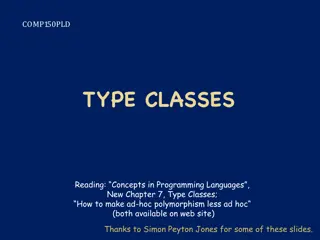
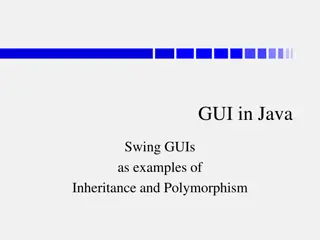

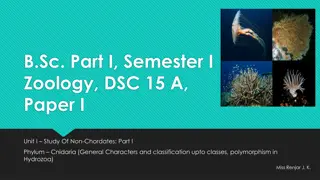
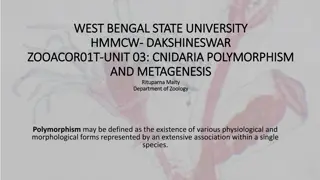
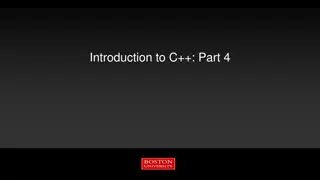
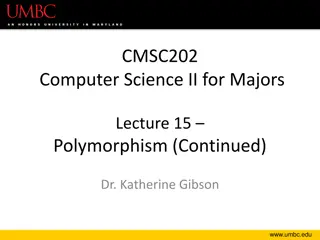


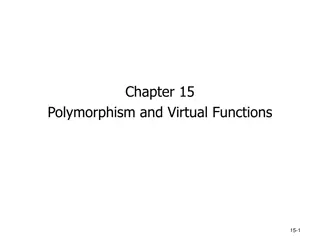
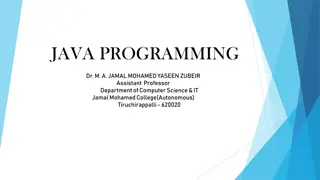
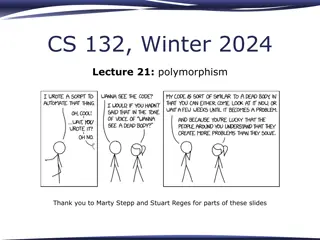
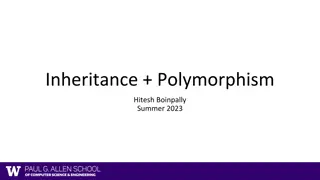
![BCH 462- Biotechnology & Genetic engineering [Practical]](/thumb/273367/bch-462-biotechnology-genetic-engineering-practical.jpg)

